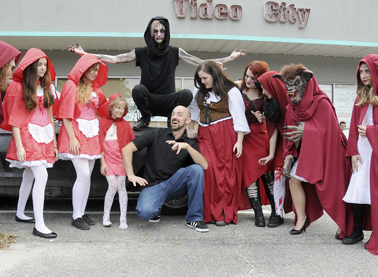
Madness and Mayhem President Chris Scott, center, developed the "Don't stray from the path" experience for this year's haunted house experience. It runs from Oct. 9 - Oct. 31 at the Video City building in High Springs.
HIGH SPRINGS – There are about a dozen of them that you’ll run into as you make your way through 3,000 square feet of horror. If you dare to venture through the Madness and Mayhem Haunted House experience starting on Oct. 9, you will meet Little Red Riding Hood over and over.
She’s hiding under there and jumping out at you around the next corner. Screaming and moaning and then there’s a grandma who is unlike any grandma you’ve ever met– let’s hope.
Welcome to “Don’t Stray From the Path,” a story that plays out as you meander through darkness surrounded by screams, saw blades running and lightning effects among other secret scary tactics we cannot reveal.
Madness and Mayhem President Chris Scott said he has the Grimms’ Fairy Tales book close by him, next to his bed as a matter of fact, and used it for inspiration when he came up with the plot for his second haunted house design experience.
“There are lots of Reds,” he says about the variations of the lead character that make appearances throughout the event. “But only one,” he adds. “They are really variations.”
More than 100 volunteer actors and behind-the-scenes support crew members have come to help this year’s production which will raise funds for community causes.
According to Scott, proceeds will be divided between Music and Arts Program for Youth in Alachua (MAP for Youth) of Alachua, Plenty of Pitbulls, Our Santa Fe River and High Springs Historical Society. MAP for Youth teaches art, manners and life skills to Alachua County youth, he said.
Sponsors of the haunted house include Sysco, Digitel Video LLC, Great Outdoors, Chris Doering Mortgage, Grady House Bed & Breakfast, North Central Florida Advertiser, Ray Carson Photography, Ladonna D Boyette, True Blue Café, David’s Real Pit BBQ & Catering, McDonald’s of Alachua, Campus Scooters, AAA Event Services LLC, Bret’s Bikes, The Diner, and Old Irishman’s Pawn Shop.
But it is the volunteers that make the show come together Scott and technical coordinator Andy Phelan both claim.
Phelan is the mind behind making the special effects happen. “It starts with Chris’s ideas,” Phelan said. “And I’m the guy who makes it work. My main job is the technical part of it, seeing that the stairs work, that we have light in the right places, seeing that it’s safe.”
The volunteers this year range from age 8 to 76.
A recent dress rehearsal gave those volunteers a chance to practice makeup skills and refine their roles so visitors seeking the adrenaline rush from fear won’t be disappointed.
“He needs an open wound, so I’m trying to decorate him.” actor Zach Malcki said. He was getting the guts all bloody and ready on actor Andrew Ensey from Lake City. Once you meet Andrew’s character, you’ll never forget him.
According to one of the Little Riding Hoods, “I’m supposed to shake around the cage and if somebody comes by I reach out my hand and say ‘Help Me’,” said Mallory Gaerhardt, 12, a student at Bronson Middle School.
Karl Biddle a senior from Fort White High School said his job is “a creepy gardener that comes out from behind a statue and scares people.”
Dakota Stitsinger and Kaitlin New are wearing red contact lenses and both play versions of Riding Hood.
“They’re a little weird to get used to because they move,” Stitsinger said. “Everything in my peripheral is tinted red. But other than that I can see fine. We’re the evil Little Red Riding Hood. Our job is to kill the wolf.”
And then there is the werewolf transformation.
Victoria Wedgwood, 16, of High Springs, attends Santa Fe High School. “That’s not me howling,” she says about the werewolf sound effects playing in the background. She will transform into a werewolf throughout the storyline.
“I attack granny,” says Sydney Cadrain of Fort White. Watch out for her, she is sitting in the corner looking like a werewolf only she’s wearing stockings and high heels.
Lisa Gonzalez is putting makeup on actors, but she is a also the butcher. This is her second year volunteering, she says.
Amelia MacCallum, 13, of Oakview Middle School is a “bench” Red, she said. She becomes mean after being attacked by a wolf. “I did it last year,” she said. “I like doing the makeup. It starts to itch after a while.”
Outside, Aidan Birmingham is a scary villager marching with his arms out in front of him covered in blood and scars.
The host at the door will tell you when you arrive, “Stay in your group. If you stray from the path, they will hunt you down. You must not touch the actors and the props, they will hunt you down.”
Our advice?
Watch out for the wolves, don’t go there alone, stick together and be prepared for all of the screaming and howling.
And look out as the sound of an organ playing crescendos. It means you are getting closer and closer to?
If you hear someone scream: “Get out, hurry!” and the sound of saw blades, and screams of pain, torture and blood, it will be okay. Just don’t freak out as you make your way through a pitch dark space holding onto whoever is closest. So many twists and turns.
Don’t stray from the path or they might just hunt you down.
And if you have little ones who might want to come by, this year, Madness and Mayhem will host a “lights on not so scary,” walkthrough Scott said. “People from the City (High Springs) will be handing out candy in some of the rooms on Halloween,” he said.
“It’s a good way for the community to come through without being terrified.”
The Madness and Mayhem’s 2015 Haunt will be held in the old Video City building at 19975 NW 244th St., in High Springs, each Friday and Saturday starting Oct. 9 – Oct. 31. For hours of operation and more information, please visit their website at madnessandmayhem.org or call president, Chris Scott at 352-226-5909.
# # #
Email scook@
alachuatoday.com







 ALACHUA – The Alachua City Commission unanimously approved on Monday the implementation of a master plan to construct a large city park adjacent to the Hal Brady Recreation Complex.
ALACHUA – The Alachua City Commission unanimously approved on Monday the implementation of a master plan to construct a large city park adjacent to the Hal Brady Recreation Complex.